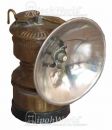We've tried to ensure the information displayed here is as accurate as possible. Should there be any inaccuracies, we would be grateful if you could let us know at info@ipohworld.org . All images and content are copyright.
(Please click on the thumbnail for a bigger image.)
Rubber Tapper's Headlamp

Carbide lamps (acetylene lamps) are simple lamps that produce and burn acetylene (C2H2) gas produced by reacting calcium carbide (CaC2) with water. These lamps were formerly found in underground mines (not to be confused with the Davy lamp), on vintage cars, lighthouses, bicycles and in Malaya by the rubber tappers, who wore them on their hat or headband; they are still sometimes used by cavers, hunters, and cataphiles.
Pellets or chunks of calcium carbide are placed in the lower chamber (the generator). The upper chamber is then filled with water. A screw valve or other mechanism is used to control the rate at which the water is allowed to drip into the chamber containing the calcium carbide. By controlling the rate of water flow, the production of acetylene gas is controlled. This, in turn, controls the size of the flame which has a reflector behind it to redirect light in a more useful direction.
This particular lamp is made of brass and stands 10cm high with a reflector of 8cm diameter. Control of the flame is by a graduated lever at the top of the lamp. The lamp is marked 'Good Morning' on the top. Originally imported from England this example is probably locally made.
To read more about the history of Rubber Plantations and Tappers, click here.
To read more about actual Rubber Tapping and Production, click here.